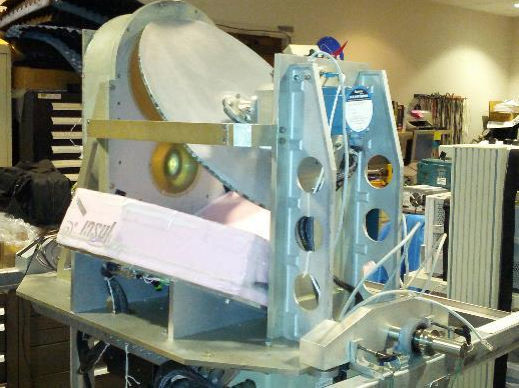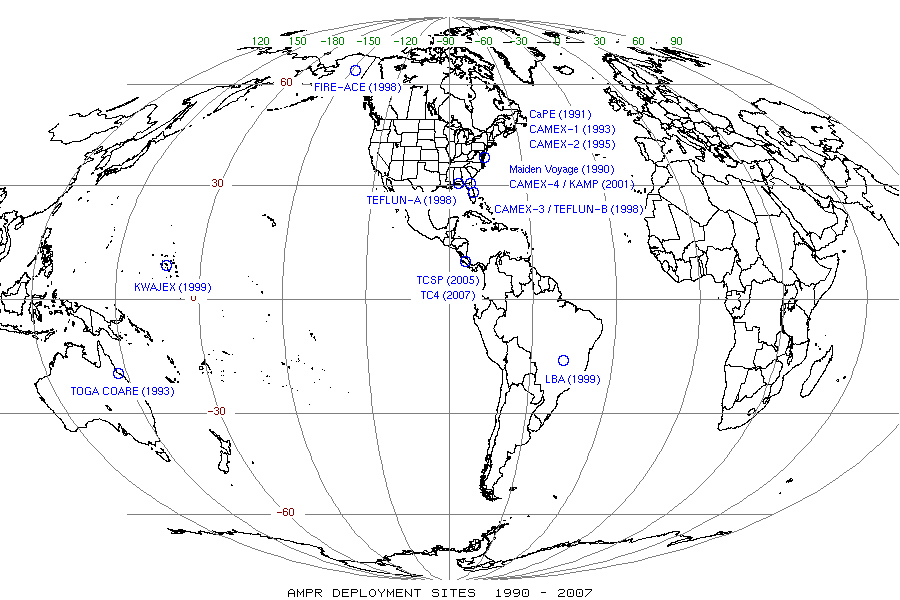Instrument: Advanced Microwave Precipitation Radiometer (AMPR)
The Advanced Microwave Precipitation Radiometer (AMPR) is a multi-frequency, dual-polarized, cross-track scanning passive microwave radiometer managed by NASA Marshall Space Flight Center (MSFC). The AMPR radiometer has flown on the NASA ER-2 and DC-8 aircraft. AMPR measures microwave brightness temperatures at four calibrated microwave frequencies: 10.7, 19.35, 37.1, and 85.5 GHz, from which cloud, precipitation, water vapor, and surface properties (including ocean winds) can be derived. These frequencies are sensitive to the emission and scattering of precipitation-sized ice, liquid water, and water vapor (Hood et al. 2006). AMPR scans at 90 degrees cross-track, perpendicular to the direction of aircraft motion. The data are geolocated based on scan angle and aircraft position and altitude information. AMPR has a dual-lens antenna to accommodate two separate feed horns. The higher frequency channel horn is a copy of the Special Sensor Microwave/Imager (SSM/I) spaceborne multifrequency feed horn currently flying onboard the Defense Meteorological Satellite Program (DMSP) satellites. A separate AMPR feed horn, built by the Georgia Technology Research Institute (GTRI), accommodates the 10.7 GHz frequency. More information about AMPR can be found at https://weather.msfc.nasa.gov/ampr/


AMPR measures microwave brightness temperatures at four calibrated microwave frequencies: 10.7, 19.35, 37.1, and 85.5 GHz, from which cloud, precipitation, water vapor, and surface properties (including ocean winds) can be derived.

| Microwave Frequency (GHz) | Bandwidth (MHz) | Integration Time (ms) | Horn Type | Lens Diameter (inches) | Beam Width (degrees) | Footprint (km) at 20 km ER-2 Flight Altitude | Footprint (km) at 11 km DC-8 Flight Altitude | Beam Efficiency (%) | Cross Polarization (%) |
|---|---|---|---|---|---|---|---|---|---|
| 85.5 | 1400 | 50 | SSM/I | 5.3 | 1.8 | 0.64 | 0.36 | N/A | N/A |
| 37.1 | 900 | 50 | SSM/I | 5.3 | 4.2 | 1.48 | 0.83 | 98.8 | 0.4 |
| 19.35 | 240 | 50 | SSM/I | 5.3 | 8.0 | 2.78 | 1.56 | 98.7 | 1.6 |
| 10.7 | 100 | 50 | GTRI | 9.7 | 8.0 | 2.78 | 1.56 | 97.8 | 0.2 |
Hood, R. E., Cecil, D. J., LaFontaine, F. J., Blakeslee, R. J., Mach, D. M., Heymsfield, G. M., & Goodman, M. (2006). Classification of tropical oceanic precipitation using high-altitude aircraft microwave and electric field measurements. Journal of the Atmospheric Sciences, 63(1), 218–233. http://doi.org/http://doi.org/10.1175/jas3606.1
Hood, R. E., Spencer, R. W., LaFontaine, F. J., & Smith, E. A. (1994). Simulation of Future Microwave Satellite Instruments Using High Resolution AMPR Aircraft Data. In Seventh Conference on Satellite Meteorology and Oceanography (Vol. Section 3., pp. 160–163).
Lang, T., Roberts, B., Meyer, P., Cantrell, E., Wolff, D. (2015). AMPR and radar observations from IPHEx: Data quality control and product generation. Retrieved from https://ntrs.nasa.gov/archive/nasa/casi.ntrs.nasa.gov/20150022943.pdf
Leppert, K. D., & Cecil, D. J. (2015). Signatures of hydrometeor species from airborne passive microwave data for frequencies 10-183 GHz. Journal of Applied Meteorology and Climatology, 54(6), 1313–1334. http://doi.org/10.1175/JAMC-D-14-0145.1
Skofronick-Jackson, G. M., Gasiewski, A. J., & Wang, J. R. (2002). Influence of microphysical cloud parameterizations on microwave brightness temperatures. IEEE Transactions on Geoscience and Remote Sensing, 40(1), 187–196. http://doi.org/10.1109/36.981360
Spencer, R. W., Hood, R. E., LaFontaine, F. J., Smith, E. A., Platt, R., Galliano, J., … Lobl, E. (1994). High-Resolution Imaging of Rain Systems with the Advanced Microwave Precipitation Radiometer. Journal of Atmospheric and Oceanic Technology, 11(40), 49–857. https://doi.org/10.1175/1520-0426(1994)011<0849:HRIORS>2.0.CO;2
Vivekanandan, J., Turk, J., & Bringi, V. N. (1993). Comparisons of Precipitation Measurements by the Advanced Microwave Precipitation Radiometer and Multiparameter Radar. IEEE Transactions on Geoscience and Remote Sensing, 31(4), 860–870. http://doi.org/10.1109/36.239909









